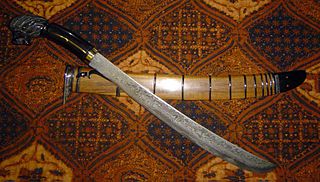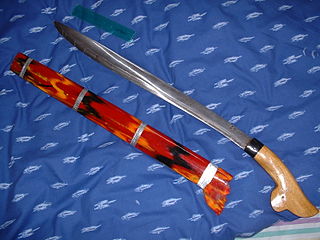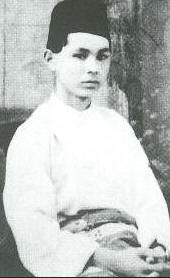
The Malay Peninsula or also known as Segaramsin Peninsula is a peninsula in Mainland Southeast Asia. The landmass runs approximately north–south, and at its terminus, it is the southernmost point of the Asian continental mainland. The area contains Peninsular Malaysia, Southern Thailand, and the southernmost tip of Myanmar (Kawthaung). The island country of Singapore also has historical and cultural ties with the region. The indigenous people of the peninsula are Orang Asli and Malays, an Austronesian people.

Silat Melayu, also known as Seni Persilatan Melayu or simply Silat, is a combative art of self-defence from the Malay world, that employs langkah ('steps') and jurus ('movements') to ward off or to strike assaults, either with or without weapons. Silat traced its origin to the early days of Malay civilisation, and has since developed into a fine tradition of physical and spiritual training that embodies aspects of traditional Malay attire, performing art and adat. The philosophical foundation of modern Malay Silat is largely based on the Islamic spirituality. Its moves and shapes are rooted from the basis of Silat movements called Bunga Silat, and Silat performances are normally accompanied with Malay drum assembles.

Malays are an Austronesian ethnic group native to eastern Sumatra, the Malay Peninsula and coastal Borneo, as well as the smaller islands that lie between these locations. These locations are today part of the countries of Malaysia, Indonesia, southern part of Thailand, Singapore and Brunei Darussalam.

The 13 May incident was an episode of Sino-Malay sectarian violence that took place in Kuala Lumpur, the capital of Malaysia, on 13 May 1969. The riot occurred in the aftermath of the 1969 Malaysian general election when opposition parties such as the Democratic Action Party and Gerakan made gains at the expense of the ruling coalition, the Alliance Party.

A golok is a cutting tool, similar to a machete, that comes in many variations and is found throughout the Malay archipelago. It is used as an agricultural tool as well as a weapon. The word golok is used in Indonesia and Malaysia and in the Philippines. Both in Malaysia and in Indonesia, the term is usually interchangeable with the longer and broader parang. In the Sundanese region of West Java it is known as bedog.
Indonesian and Standard Malay are two standardised varieties of the Malay language, the former used officially in Indonesia and the latter in Brunei, Malaysia and Singapore. Both varieties are generally mutually intelligible, yet there are noticeable differences in spelling, grammar, pronunciation and vocabulary, as well as the predominant source of loanwords. The differences can range from those mutually unintelligible with one another, to those having a closer familial resemblance. The regionalised and localised varieties of Malay can become a catalyst for intercultural conflict, especially in higher education.

The parang is a type of knife used across the Malay archipelago. It is often mistakenly assumed to be a sword; however, there is no evidence that it has ever been used in a formal military conflict, nor that its intended purpose was to be used as a combat weapon. Although some may argue that it could be called a machete or a chopper as it is a direct variation of the modern machete, its academic status remains as a knife.

Pencak silat is an umbrella term for a class of related Indonesian martial arts. In neighbouring countries, the term usually refers to professional competitive silat. It is a full-body fighting form incorporating strikes, grappling, and throwing in addition to weaponry. Every part of the body is used and subject to attack. Pencak silat was practiced not only for physical defense but also for psychological ends. There are hundreds of different pencak silat styles and schools which tend to focus either on strikes, joint manipulation, weaponry, or some combination thereof.

Baju Melayu is a traditional Malay costume for men, originated from the court of Malacca Sultanate and is traditionally worn by men in Brunei, Malaysia, Singapore, parts of Indonesia, southern Philippines, and southern Thailand. In its formal form, Baju Melayu is the national dress of Malaysia and Brunei, typically worn during official events and functions.

Malaysian Malays are Malaysians of Malay ethnicity whose ancestry originates wholly or partly in the Malay world. According to the 2023 population estimate, with a total population of 17.6 million, Malaysian Malays form 57.9% of Malaysia's demographics, the largest ethnic group in the country. They can be broadly classified into two main categories; Anak Jati and Anak Dagang.

Listed here are the weapons of pencak silat. The most common are the machete, staff, kris, sickle, spear, and kerambit. Because Southeast Asian society was traditionally based around agriculture, many of these weapons were originally farming tools.

The Pandat is the war sword of the Dayak people of northwest Borneo and is never used as a tool. On October 18, 2016, this weapon was featured in season 3 episode 9 of the American bladesmithing competition series Forged in Fire.

Parang Nabur is a sword that originates from Banjarmasin, South Kalimantan, Indonesia. Most of these swords were made during the Banjarmasin Sultanate period in the 19th century.

Sewar refers to a dagger of Indonesian origin, typically carried in a belt and used mainly in Sumatra, Indonesia. The blade is also referred to as Sewah by the Gayo people, Seiva by the Minangkabau people, Siva by the Alas people, and Siwaih by the Acehnese people.

Parang Latok is a sword from Borneo in Sarawak, Malaysia; where it is regarded as the national weapon of the Sarawakian Malay people and the Bidayuhs, and as well as Kalimantan, Indonesia. It also functions as a machete.

The Amanremu is a sword from North Sumatra, Indonesia.

The Kelantanese klewang or Kelantanese kelewang is a style of klewang originating from Kelantan, Malaysia but is also popular in other northern Malaysia Peninsula states such as Kedah and Perlis.

A kudi or kudhi is a bladed tool from Banyumas, Indonesia.

Traditional Malaysian art is primarily composed of Malay art and Bornean art, is very similar with the other styles from Southeast Asia, such as Bruneian, Indonesian and Singaporean. Art has a long tradition in Malaysia, with Malay art that dating back to the Malay sultanates, has always been influenced by Chinese, Indian and Islamic arts, and also present, due to large population of Chinese and Indian in today's Malaysian demographics.

The Parang Ginah is a sickle shaped Malay cutting implement, whether a sword or a sickle is uncertain, most likely the latter.




















